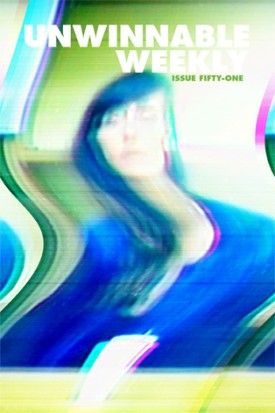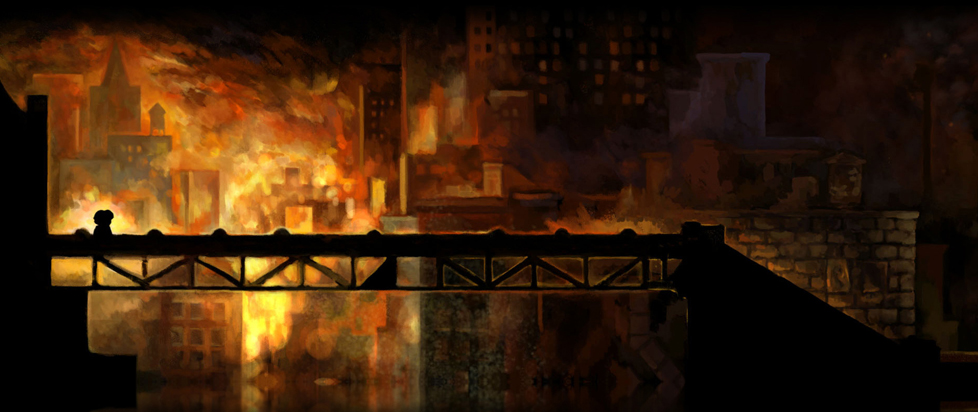
A Tale of Two Women
The following is a reprint from Unwinnable Weekly Issue Fifty-One. If you enjoy what you read, please consider purchasing the issue or subscribing.
———
Editor’s Note: Read this story after finishing Her Story.
Across fragments of old tapes, a woman is repeatedly interviewed by police about her missing husband. Bit by bit, Her Story comes together, but is this a murder mystery or a mystery of a different kind?
I love this game. I loved Sam Barlowe’s game Aisle from years ago, though Her Story plays more like Emily Short’s Galatea, a game I also loved, both of which you listen to a bit of story then use that knowledge to probe for more backstory. It’s fascinating to play and it’s about relationships between many women, which I’m always proponent of. I mean Virginia Woolf wrote A Room of One’s Own in 1929 for fuck’s sake, digital fiction should be forthcoming with stories about the relationships between women already.
I turned the page and read . . . I am sorry to break off so abruptly. Are there no men present? Do you promise me that behind that red curtain over there the figure of Sir Charles Biron is not concealed? We are all women you assure me? Then I may tell you that the very next words I read were these — ‘Chloe liked Olivia . . . ’ Do not start. Do not blush. Let us admit in the privacy of our own society that these things sometimes happen. Sometimes women do like women.
‘Chloe liked Olivia,’ I read. And then it struck me how immense a change was there. Chloe liked Olivia perhaps for the first time in literature. Cleopatra did not like Octavia. And how completely Antony and Cleopatra would have been altered had she done so! As it is, I thought, letting my mind, I am afraid, wander a little from Life’s Adventure, the whole thing is simplified, conventionalized, if one dared say it, absurdly. Cleopatra’s only feeling about Octavia is one of jealousy. Is she taller than I am? How does she do her hair? The play, perhaps, required no more. But how interesting it would have been if the relationship between the two women had been more complicated. All these relationships between women, I thought, rapidly recalling the splendid gallery of fictitious women, are too simple. So much has been left out, unattempted. And I tried to remember any case in the course of my reading where two women are represented as friends. There is an attempt at it in Diana of the Crossways. They are confidantes, of course, in Racine and the Greek tragedies. They are now and then mothers and daughters. But almost without exception they are shown in their relation to men. It was strange to think that all the great women of fiction were, until Jane Austen’s day, not only seen by the other sex, but seen only in relation to the other sex. And how small a part of a woman’s life is that; and how little can a man know even of that when he observes it through the black or rosy spectacles which sex puts upon his nose. Hence, perhaps, the peculiar nature of woman in fiction; the astonishing extremes of her beauty and horror; her alternations between heavenly goodness and hellish depravity — for so a lover would see her as his love rose or sank, was prosperous or unhappy.
Aisle was, among other things, about how a character remembers his ex-lover. It’s explicitly a man’s feelings about a woman. Her Story attempts this much trickier, less explored territory of fiction: a woman in her own words.
That said, I don’t think this story is that well grounded. A midwife steals a twin baby? Hides it away? The child then secretly lives in an attic in her twin’s house? Then a miscarriage? Then parents mysteriously die? The whole plot seems propelled by high cliche and conveniences, not character, circumstance, place and culture. There are three possible explanations for the story, but I don’t think any of them justify the paper-thin characterizations.
1. One woman pretending to be two and inventing a fantastical story to give herself an alibi. I find that boring. If this is the explanation, this isn’t a particularly nuanced portrayal of someone feigning dissociative identity disorder (multiple personalities), and it erases the story and motive. Unlike, say, a certain mid-90s film about a suspect inventing an elaborate story, it doesn’t have the hint of another truth. It’s too simple. It’s the inexplicable “hellish depravity” described by Virginia Woolf.
2. One woman who truly has dissociative identity disorder, where Eve is Hannah’s alternative personality she tries to suppress, who murders her family and seduces her husband. This is a “she’s mentally ill” cop-out that’s cliche and a poor portrayal of dissociative identity disorder to boot. It means the story isn’t saying anything about relationships or sibling rivalry at all; it erases the most interesting parts of the character study without saying anything about how a person might struggle with mental illness. It’s a gotcha used as an excuse for shoddy storytelling.
I have a good friend who sometimes has psychosis. Psychosis isn’t always violent or extreme, despite how TV and movies tend to portray it. Sometimes we have coffee and she’s just my old friend, talking about her new job and the people she’s hanging with; Sometimes we have coffee and she believes incredibly strange things about, say, the way certain songs can undo time. This game could have portrayed interviewing a mentally ill subject who believes untrue things, or believes different things in different states, and let the player uncover the reality of it, but Her Story doesn’t resemble my actual experiences of talking to someone like that at all. (Not to imply psychosis and dissociative identity disorder are interchangeable — they’re not.)
3. Two women pretending to be one (at first), who might have embellished their story at points. This is where most of the plot seems to point, and if you’re going to have a twist, to me this one says the most interesting things about people, about identity and obsession. It implies that part of their drama plays out before us as the police unwittingly reveal to Hannah that Eve is pregnant by Simon, possibly causing Eve to kill Hannah.
This last one, a story about two women, is the most demanding to write, and I hope it’s what Sam Barlow set out to portray. I feel like this was a plot that could have been built out believably, deeply. Yet I find it so frustrating because despite being called Her Story, it keeps dodging the opportunity to say anything about women’s real experiences.
For instance, there’s a lot of reasons that twins are separated in the real world, they don’t usually involve nefarious midwives. If Hannah and Eve are 27 in 1994, they were born in 1967. Forced adoption was still a thing for teen pregnancies back then. Likewise, the portrait painted of how two girls can relate through play and secrets and codes, who grow up in tune and then find their relationship becoming fractured, is human and promising but it is also barely sketched. Who are these people? Where are they from, specifically? What is that house like beyond having the spatial necessities of lounge, kitchen, cellar and attic? I don’t get any sense of what kind of parents they have, who make 17-year-olds marry.
 Without characterisation, this detail’s only purpose seems to be an easy plot fix. All the details feel overly broad. Simon is… nice? Shy? The only time I get a real sense of that is the dorky pick-up-line he uses on Eve and the innocence of chips on the beach. 1994 doesn’t seem to exist beyond a CRT shader and some blazers. No reference suggests why this particular time and place might have informed her behavior. Nothing elevates it beyond tropes into a specific portrayal of a particular sisterhood, a teenage pregnancy, a marriage. Compare it to games by Emily Short (whose analysis of what made the mechanics of Her Story work so well is also very good) or Fullbright or the novels of Elena Ferrante or Julian Barnes – stories with female characters that engage with domesticity and relationships and even rivalries between women without oversimplifying women’s experiences.
Without characterisation, this detail’s only purpose seems to be an easy plot fix. All the details feel overly broad. Simon is… nice? Shy? The only time I get a real sense of that is the dorky pick-up-line he uses on Eve and the innocence of chips on the beach. 1994 doesn’t seem to exist beyond a CRT shader and some blazers. No reference suggests why this particular time and place might have informed her behavior. Nothing elevates it beyond tropes into a specific portrayal of a particular sisterhood, a teenage pregnancy, a marriage. Compare it to games by Emily Short (whose analysis of what made the mechanics of Her Story work so well is also very good) or Fullbright or the novels of Elena Ferrante or Julian Barnes – stories with female characters that engage with domesticity and relationships and even rivalries between women without oversimplifying women’s experiences.
Is it an outcome of this particular game mechanic, where certain words have to be repeated, and where plot points have to be concise, that it’s hard to write something that feels whole? I don’t think it should be. Is it a function of the plot conceit about these women sticking to a script? It still doesn’t feel well-wielded. I don’t especially care about plot holes per se — real life doesn’t make perfect sense either — I think I just care about a strong sense of a world and a strong sense of the people in it and I didn’t get either from this game.
There are things I like about the plotting — there’s a lot to uncover, not just one twist but all sorts of dark details. Part of writing well-written women characters means sometimes writing nasty ones. I like that Eve is selfish, in her way. She is interesting as a psychopath and could potentially be an even more interesting one. Sibling violence & abuse is still something parents sweep under carpets, hoping their children will grow out of it, especially when both children get along sometimes, even when one child is clearly bullying the other, even while we’re beginning to recognize that some interpersonal abuse situations don’t resemble our assumptions. There’s a lot to unpack there that I feel Her Story oversimplifies, falls back on stereotypes of catty women fighting over men where it doesn’t have to.
I like the detail that you’re Sarah. The little instant message feels like a logical outcome of the premise of logging onto this old computer to access these police records. I like that you might first think your job is to discern if this person is guilty — but the twist is the game asks you to sympathize. But since the game is so willing to cop-out of its own storytelling, what are we sympathizing with?
Her Story is incredibly good at jolting the part of our brain that seeks out motivations. I’ve read once that humans can have trouble calculating some logic problems, but when those problems are framed as checking other humans for cheating, we find the same logic much easier. Our ability to reassemble complex stories is heightened when we suspect other humans of deceit.
It really felt amazing chasing down hunches to see what I could find, to have my guesses confirmed or denied, to hunt back to find those last pieces. I loved this mechanic even though I found the story shallow, like enjoying a jigsaw puzzle but not the image that’s on it. I loved the promises it made. I hope these three (Aisle, Galatea, Her Story) aren’t the only three games like this, where you have to actively search and follow leads to reassemble stories.
You could apply the same mechanic to a story about an old person giving their life story, a reconstruction of a historical event, to an examination of recurring dreams, to. The stories are limitless.
———
Claire Hosking is a grad architect and illustrator interested in digital architecture, procedural art and robots. Models assets and programs gameish things.





